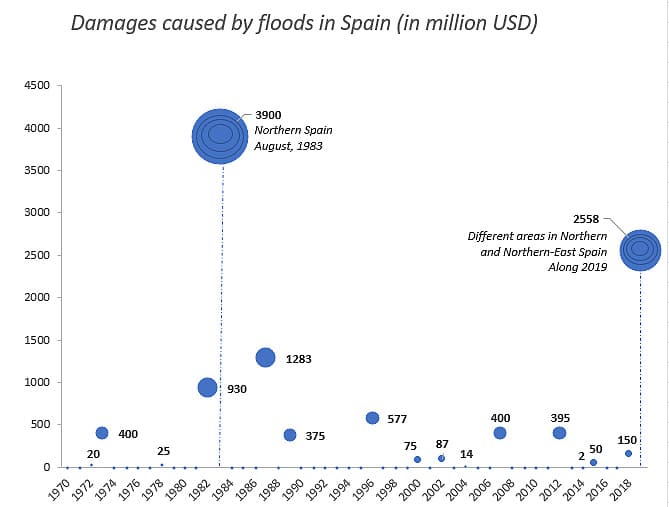Climate Change Adaptation in Spain: When a Plan is not Enough
Reducing carbon emissions is no longer enough to reduce the effects of climate change, making climate adaptation – the process of adjustment to climate change and entailing hazards – necessary. Cristina Bernal Aparicio takes a look at Spain’s climate adaptation plan, its flaws, and its potential.
In Spain, floods have been the natural hazards that have caused most economic and life losses. To better understand the economic impacts of such hazard, the graph below shows the damages in million USD from 1970 to 2019 in Spain. In the figure, two major floods stand out: the 1983 floods, which caused a total estimated damage of 3,900 million USD and affecting more than half a million civilians in northern Spain’s Basque Country region and other provinces of the north east, and the 2019 floods, with damages mounting up to 2,558 million USD, affecting several communities across the north east of the country.

Produced by the author based on the EM-DAT database.
Data on damages provides a good snapshot of a country’s exposure to climate risks. With increasing temperatures, the probability and intensity of meteorological hazards, like droughts and storms, will likely augment. This situation translates to even larger financial damages, which is especially problematic for Spain, one of the countries most affected socio-economically by COVID-19 in Europe.
Flood Adaptation and Climate Change Adaptation Plans
Spain developed its first National Climate Change Adaptation Plan from 2006 to 2020. Based on lessons learned from this first plan, the second plan was adopted from 2021 to 2030. It constitutes a useful resource to identify objectives, criteria, scope of work, and action lines to foment climate change adaptation and resilience.
The involvement of provincial and municipal decision makers in climate change adaptation is as essential as that of national stakeholders. However, according to a 2019 report on local policies targeting climate change, only 28.9 per cent of the municipal and provincial governments in Spain (which account for around 62 per cent of the country’s population) committed to sustainability have concrete climate change adaptation plans. Furthermore, only 15 per cent contributed to the report themselves, showing low priority among members who supposedly prioritise sustainability and climate change.
Not only is there low (or lower) prioritisation in adapting to climate change by municipalities, but none of the existing climate change adaptation projects developed in Spain to date target flooding and sea level rise.
Main Flaws From the Adaptation Plans
The lack of interest in climate change adaptation can be explained by a general lack of awareness and the weaknesses from the first plan of climate adaptation. According to the evaluation report of the first adaptation plan, one significant flaw is that the plan did not potentiate the development of specific strategies by sector, that it lacked easy and precise indicators to monitor and evaluate, and lacked indicators to evaluate the national adaptation level.
The lines of action described in the second Climate Change Adaptation Plan contain essential elements for informed decision making. These include research on climate change’s impacts on ecosystems, climate services for urban planning; and suggestions how to advance climate change adaptation in the country, such as through the inclusion of climate change adaptation at the policy level and the coordination of related policies such as on desertification and forest fires. Despite such developments, the indicators to evaluate the achievement of the national plan remain quite vague and, most of them, not measurable.
For example, line of action three addresses issues regarding water and hydric resources such as contingent management of drought risks and its integration into hydrological and water management. One of the indicators states: “Exploitation rates are reduced in watersheds with excessive values”. The question here is: at what rate, on average, is to be reduced, and when should this be completed?
The same plan states that “the indicators are provisional and constitute a first step for creating a set of indicators that will be improved when more knowledge is created”. This may be the reason why the indicators are not entirely accurate and not measurable yet. In any case, developing accurate and quantifiable indicators with clear benchmarks should be a priority for the working groups behind each of the lines of action, since it is of their interest and of the society’s to be able to track the evolution of adaptation efforts. At the same time, this allows to identify gaps and prioritise actions.
An additional remark is related to finance, where none of the lines of action specifies the total amount of budget allocated, neither do the sectors. Cost estimates for each of the lines of action are also missing. While these estimates may be hard to make, they could have been presented in ranges, since it allows key stakeholders to have more accurate expectations on what can actually be done. Furthermore, this additional information increases transparency since it would be openly available to the rest of the population.
Conclusion
As of today, the simple assessment constituting the base for climate change adaptation in Spain is not enough. Spain is not ready for future hazards and, hence, for the impacts of climate change. As observed in the second National Climate Change Adaptation Plan, it seems like Spain is still at the initial stages of climate change adaptation. The country still lacks, among many other aspects, measurable indicators, deadlines for accomplishment, specificities about budget allocations, and, most importantly, a society aware of the Climate Change Adaptation Plan and its increasing importance. Although the second plan provides a valuable document to enhance adaptation in Spain, the country has still a long way to go until climate change adaptation is met with the necessary urgency.
